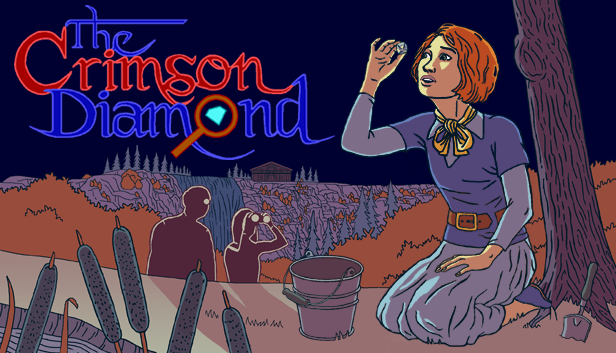But don’t get it wrong—you can definitely die —
The parser works much better than you’d think, and the mystery is pitch-perfect.

In my mind, this image is slowly drawing into place, with the text arriving last.
Julia Minamata
A text parser? Typing in “Open drawer,” then “Look in drawer,” then “Take brochures,” in the year 2024, on a computer that can generate a 4K 3D model of the Acropolis if I ask it to? Is that really what The Crimson Diamond asks of us?
Yes, it is, and solo developer/writer/producer Julia Minamata is right to ask it. If you have text-prompt adventures from the likes of Sierra in your mental library (like, say, The Colonel’s Bequest), or if you’re willing to meet the parser halfway, it will work. The Crimson Diamond’s parser is fairly agile, accepting a range of nouns and verbs in most circumstances. You can still use arrow keys and a mouse to move and click a few useful shortcuts. And the parser has shortcuts, like typing “n” to look at your quest-tracking notebook or “o d” or “o c” for the very common actions of opening a door or cabinet.
There are a lot of cabinets and drawers in this game because it’s set in northern Ontario, Canada, in 1914. You are Nancy Maple, a junior geologist eager for some field work, sent by your museum to the mining town of Crimson to investigate a diamond that fell out of a river fish’s guts. Everything goes wrong with your trip, and you’re on your own to investigate this town, its odd inhabitants and visitors, and, eventually, a crime that may or may not have to do with potential diamonds.
-
The tutorial room does a great job introducing you to the control scheme: arrow keys or mouse cursor for movement and selecting, but typing for actual action.
Julia Minamata
-
You spend a fair deal of time in the lodge, talking and looking and picking up little things you know you’ll use later.
Julia Minamata
-
Cutscenes give the artist new angles from which to demonstrate their remarkable EGA prowess.
Julia Minamata
-
The characters in this game are richer than you might remember from more memory-limited days, usually having more than one note to them.
Julia Minamata
A few disclosures must be made. For one, Minamata crafted the EGA-style social avatar for Ars Senior AI Reporter Benj Edwards, who tipped me to this game’s existence. Another is that this is a game that costs $15 on Steam or Itch.io (and 10 percent off on Steam in this first week after release), was made by a solo Canadian developer, with music by notably cool keyboard person Dan Policar, and it evokes some of my earliest, pre-Maniac-Mansion adventure game memories. I also have not played the game to completion. I will not be taking a critical gem loupe to it; I just think more people need to know about it.
Release trailer for The Crimson Diamond
Nostalgia and underdog-cheering sentiments aside, The Crimson Diamond looks and sounds great. The creative constraints of an EGA-like color palette and pixel block size delivered some scenes that are just wonderful to look at. The soundtrack loops about in pleasant and occasionally ear-catching fashion. Alice Bell at Rock Paper Shotgun played much further into this (about six hours and near or at completion), and her major complaint is almost a throwback: a few puzzles with obscure solutions, entirely too easy to miss with text parsing and EGA graphics.
I’m eager to see where Nancy Maple’s journey takes her, even if I have to sometimes wrack my brain for the right text to do the obvious thing. The game so far has felt like spending time inside one of those non-violent mysteries you see on PBS (or CBC), just inside a familiar and evocative game form.
Listing image by Julia Minamata